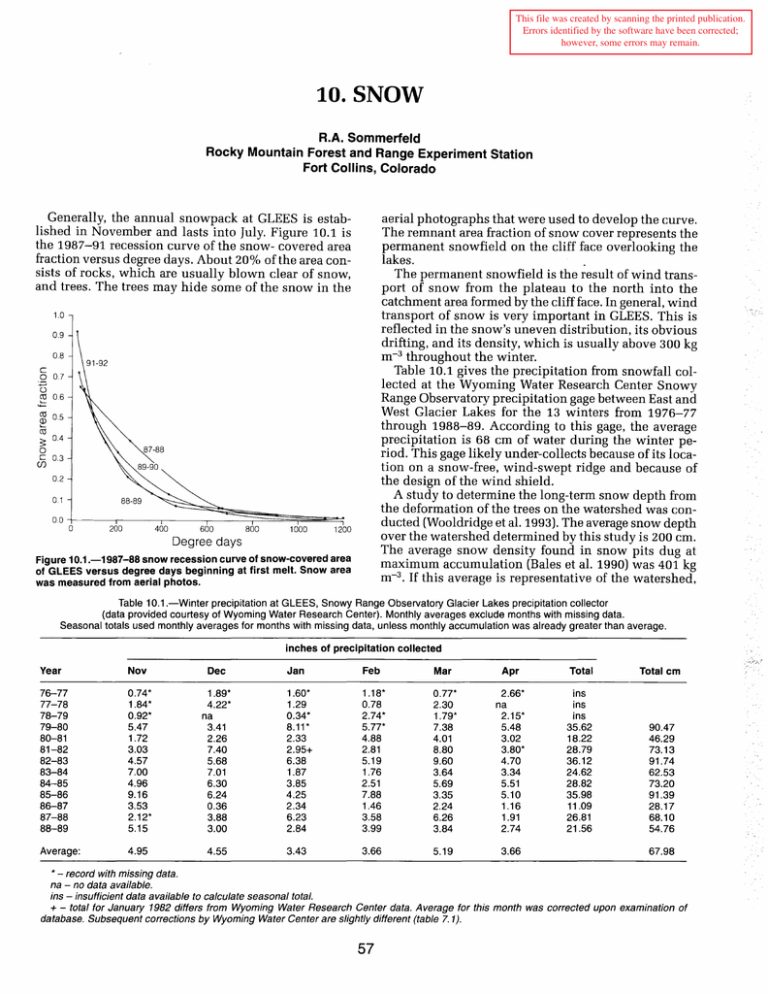SNOW 10.
advertisement

This file was created by scanning the printed publication. Errors identified by the software have been corrected; however, some errors may remain. 10. SNOW R.A. Sommerfeld Rocky Mountain Forest and Range Experiment Station Fort Collins, Colorado Generally, the annual snowpack at GLEES is established in November and lasts into July. Figure 10.1 is the 1987-91 recession curve of the snow- covered area fraction versus degree days. About 20% of the area consists of rocks, which are usually blown clear of snow, and trees. The trees may hide some of the snow in the aerial photographs that were used to develop the curve. The remnant area fraction of snow cover represents the permanent snowfield on the cliff face overlooking the lakes. . The permanent snowfield is the result of wind transport of snow from the plateau to the north into the catchment area formed by the cliff face. In general, wind transport of snow is very important in GLEES. This is reflected in the snow's uneven distribution, its obvious drifting, and its density, which is usually above 300 kg m- 3 throughout the winter. Table 10.1 gives the precipitation from snowfall collected at the Wyoming Water Research Center Snowy Range Observatory precipitation gage between East and West Glacier Lakes for the 13 winters from 1976-77 through 1988-89. According to this gage, the average precipitation is 68 em of water during the winter period. This gage likely under-collects because of its location on a snow-free, wind-swept ridge and because of the design of the wind shield. A study to determine the long-term snow depth from the deformation of the trees on the watershed was conducted (Wooldridge et al. 1993). The average snow depth over the watershed determined by this study is 200 em. The average snow density found in snow pits dug at maximum accumulation (Bales et al. 1990) was 401 kg m-3 • If this average is representative of the watershed, 1.0 0.9 0.8 c 0 0.7 ~ 0.6 'i5 cU 0.5 Q) ru ~ 0 c (f) 0.4 0.3 0.2 0.1 0.0 0 200 400 600 800 1000 1200 Degree days Figure 10.1.-1987-88 snow recession curve of snow-covered area of GLEES versus degree days beginning at first melt. Snow area was measured from aerial photos. Table 10.1.-Winter precipitation at GLEES, Snowy Range Observatory Glacier Lakes precipitation collector (data provided courtesy of Wyoming Water Research Center). Monthly averages exclude months with missing data. Seasonal totals used monthly averages for months with missing data, unless monthly accumulation was already greater than average. inches of precipitation collected Year Nov Dec 76-77 77-78 78-79 79-80 80-81 81-82 82-83 83-84 84-85 85-86 86-87 87-88 88-89 0.74* 1.84* 0.92* 5.47 1.72 3.03 4.57 7.00 4.96 9.16 3.53 2.12* 5.15 1.89* 4.22* na 3.41 2.26 7.40 5.68 7.01 6.30 6.24 0.36 3.88 3.00 Average: 4.95 4.55 Jan Feb Mar Apr Total Total em 1.60* 1.29 0.34* 8.11* 2.33 2.95+ 6.38 1.87 3.85 4.25 2.34 6.23 2.84 1.18* 0.78 2.74* 5.77* 4.88 2.81 5.19 1.76 2.51 7.88 1.46 3.58 3.99 0.77* 2.30 1.79* 7.38 4.01 8.80 9.60 3.64 5.69 3.35 2.24 6.26 3.84 2.66* na 2.15* 5.48 3.02 3.80* 4.70 3.34 5.51 5.10 1.16 1.91 2.74 ins ins ins 35.62 18.22 28.79 36.12 24.62 28.82 35.98 11.09 26.81 21.56 90.47 46.29 73.13 91.74 62.53 73.20 91.39 28.17 68.10 54.76 3.43 3.66 5.19 3.66 67.98 * - record with missing data. na - no data available. ins- insufficient data available to calculate seasonal total. +-total for January 1982 differs from Wyoming Water Research Center data. Average for this month was corrected upon examination of database. Subsequent corrections by Wyoming Water Center are slightly different (table 7. 1). 57 pulses that concentrated these ions from 4-10 times above their average concentrations. Typical of snowpacks in this climate, the water flow from the base does not begin until mid-May and continues until the seasonal snow is completely melted. This contrasts with climates in warmer areas that may have melt episodes at any time during the winter. For this reason, GLEES is ideal for studying the episodic effects from snowmelt. the average winter accumulation using these data is 80 em H 2 0. A map of distribution of snow depths at GLEES is available (Wooldridge et al. 1993). It was based on the tree study, and the contours were adjusted to conform to aerial photography of the snow distribution on June 22, 1988. It was possible to make these adjustments without violating the point depths determined from the tree forms. An estimate of the snow accumulation was made for winter 1987-88 using the technique of Martinec and Rango (1986). The estimated accumulation was 85 em H 2 0, about 106°/o of the long-term average estimated above. The Wyoming Water Research Center Snowy Range Observatory precipitation gage measured about 68 em H 2 0, about 89% of average. Taking into account the various errors in the estimates, we have concluded that the Martinec Rango estimate of 85 em of H 2 0 is likely within+ 10% for the snow accumulation in the winter 1987-88 (Sommerfeld et al. 1990). The disagreements among the estimates cannot be resolved with present data. In fact, the accurate measurement of winter precipitation into alpine watersheds is a very difficult problem and the disagreements probably cannot be resolved without the application of novel methods. Table 10.2 shows the average concentrations of several ionic impurities for snowpits dug during 1987-88. Samples from lysimeters under the snow showed ionic References Bales, R.; Sommerfeld, R.A.; Ke"Qler, D.G. 1990. Ionic tracer movement through a Wyoming snowpack. Atmospheric Environment. 24A(11): 2749-2758. Martinec, J.; Rango, A. 1986. Parameter values for snowmelt runoff modelling. Journal of Hydrology. 84: 197219. Sommerfeld, R.A.; Musselman, R.C.; Wooldridge, G.L. 1990. Comparison of estimates of snow input to a small alpine watershed. Journal of Hydrology. 120: 295-307. Wooldridge, G.l.; Musselman, R.C.; Sommerfeld, R.A.; Fox, D.G.; Connell, B.H. Mean wind patterns and snow depths in an alpine-subalpine ecosystem as measured by damage to coniferous trees. [Manuscript in preparation]. Table 10.2.-Average snow pit concentrations at snow lysimeter site, east of East Glacier Lake, 1988. Concentration, J.teq L - 1 Pit Snow water equivalent m 2 3 4L 4R 5L 5R 6L 6R 0.58 0.63 0.85 0.77 0.94 0.94 0.85 0.88 Conductivity JlM J1S SQ42- N03• Cl· Br Ca 2+ Na+ Mg2+ K+ A 1(Ill) Silica 5.0 5.2 4.7 4.7 11.7 9.7 12.9 14.4 8.2 8.7 6.0 7.1 6.9 9.7 9.8 9.4 7.8 8.6 7.8 7.8 1.7 5.4 1.7 2.0 2.1 2.2 1.4 2.1 0.0 0.0 0.1 0.8 0.0 0.0 0.0 0.0 8.6 16.3 6.9 7.9 5.8 14.7 1.2 2.7 2.5 15.9 1.8 1.8 0.9 12.2 2.0 1.1 1.4 1.8 0.4 0.6 1.5 1.8 0.8 1.4 58 H+ 4.39 4.30 6.47 5.98







